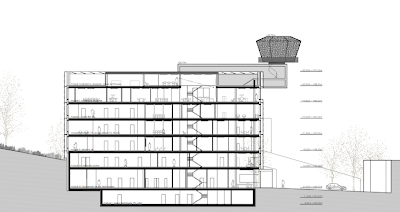20120325
Indian Point Nuclear Power Plant (NY), a case study for nuclear adaptive reuse
20120115
PDM_Nuclear power and the City_Theoritical Master Thesis







20111215
Nuclear City, PDM 11 "where are you?"






« Power plants have solid structures and are usually situated along lakes and/or rivers or have large sources of water available. The buildings have large floor space and height, making them ideal for reuse options such as museums, aquariums, restaurants, offices, hotels, libraries, science and technology centres, arts centres, industrial manufacturing facilities and stations for public transportation systems. Any number of these options may be combined. […] Redevelopment and reuse options influence the decommissioning endpoints, especially for museums or heritage facilities. In industrial museums, most of the equipment (e.g. power generators, control systems) are to be kept in the original state, and decommissioning includes cleanup actions and restoration options, but not necessarily the dismantling and demolishing of equipment and parts of buildings. The architectural scale and open spaces of former power plants are well suited for use as museums. » (IAEA, Redevelopment and reuse of nuclear facilities and sites: case histories and lessons learned, 2011, p.29)

20110829
Nuclear City, PDM 11 "coming soon"

«As a nuclear power - as the only nuclear power to have used a nuclear weapon - the United States has a moral responsibility to act.»
Barack Obama
The energy is certainly one of the biggest challenges of the 21st century. Nuclear power has long been an energetic response to this dilemma. In fact, this is a way to create energy without CO2 excess emission by maintaining a good performance. However, since the nuclear accident in Fukushima, the atom is in question. Several countries around the world, like Switzerland and Germany have begun some programs to dismantle nuclear facilities.

Dismantling a nuclear plant is in most cases total: it disappears as quickly as it appeared. In retrospect, what were the consequences of urban, social, political and territorial settlement of the nuclear infrastructure? Then, considering that zero risk does not exist. What will become the standards for implementation and security? Is there not an alternative than to destroy them? Can we possibly imagine their conversion through others programs?
20110820
20110721
clik-clak stool
20110619
Drama school for immigrants, Athens
Trough the history, Drama has always been extremely important in Greece. The city of Athens created the theatre in the 5th century B.C. to promote its culture. This invention was not only cultural but also architectural, thus creating a new typology.
Recently, Greece, and Athens in particular, have been facing economical crisis and problems linked to immigration. The neighborhood of Kerameikos and Metaxourgeio in the center of Athens are one of the most affected places by the arrival of new immigrants. More than 50% of immigrants are illiterate or have only attended primary school.
A drama school would be appropriate because it is a good way to learn a language. The educational goal would be to make interaction and communication between children easier by «learning by doing». In other words moving language study out of the classroom context would make language learning more enjoyable. The school would be run by both the National Theatre of Greece and the Ministry of Education and subsidized by private funds. Different teaching classes will take place during the day and the evening.
The site is at the crossroads of Iera Odos and Piraeus, where various cultural activities are located.The archeological site of the cemetery of Kerameikos is just in front of it which allows a direct view on the Acropolis. The plot involves two abandoned neoclassical buildings, which is frequent in Kerameikos.

The program consists of classrooms, an administration with reception and a main flexible theatre of 160 seats. The theatre can have multiple configuration of stage according the play...
20110618
EPFL gateway "Lighthouse"
It often said that one should not judge a book by its cover, but none-the less publishers and book designers go to great lengths to ensure that the covers of books are representative of the intentions of the author, and attractive enough to entice readers into the book.
20110508
Athens: city of immigrants, architecture of integration

20110429
Military airport "An Officer and a Gentlemen", agps architecture, open competition, 1st prize
20110427
20110226
RDJ contemporary art center
20110219
ecal_industrial design projects_part2
_TTT
Ikea is the most popular mall for furniture in the world. In fact it is probably one of the malls where "industrial design" really takes its full meaning.
The project is to "pimp" a basic stool from Ikea. The aim is to add a new device to make the stool more personal and original.
It is a minimal intervention which offers extra comfort to the stool. In fact, the device added to the foot steadies the stool on an uneven loor.

This project is based on the development of a standard poly-propylene sheet into a lamp. "Less is more",with fewer means and simplicity, the project uses this really good material to diffuse light.
The concept is inspired by the reel: polypropylene strips are winded around a bulb. The shape develops by itself when the hole of the band is put into the cap. The fact is that this system allows the user to personalize his lamp.

20110217
Urban chaos, a mountain case
How does a mountains village where 80% of its expansion took place in the last 40 years develop?
Verbier is a ski resort in the Swiss Alps. It is located on a southward terrace. All the urbanisation relies on foreign investors who wanted to build a lot of houses quickly in order to make a lot of money. In fact the urban plan seems to be chaotic and only ruled by money.
The analysis of this particular type of urbanism deals with its limits and the way to stop this tissue of chalet-style buildings. There are many factors which limit the expansion, the most important of which is nature: thepresence of ravines, the danger of avalanche...
































